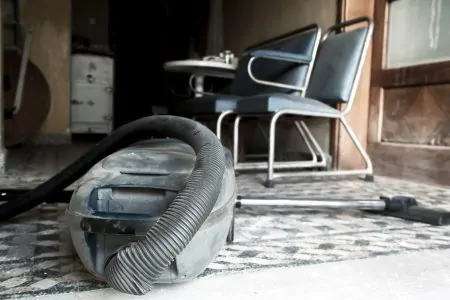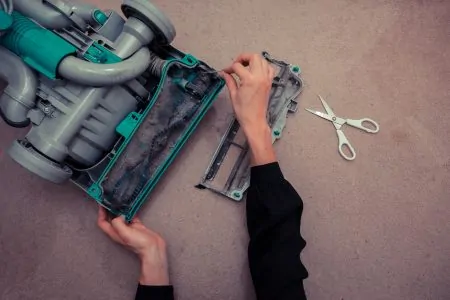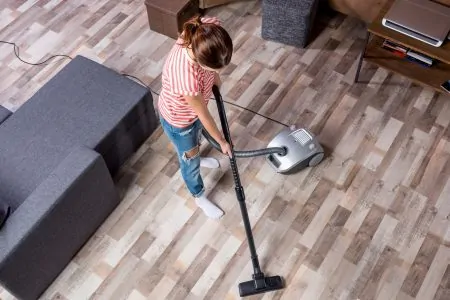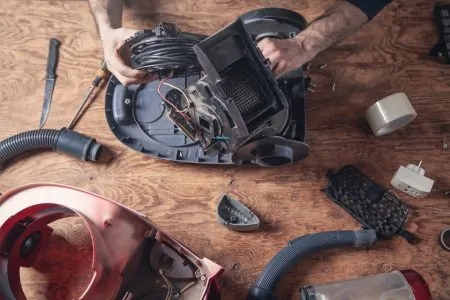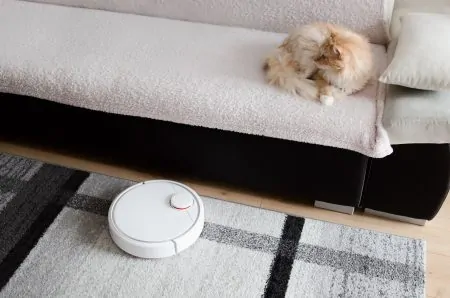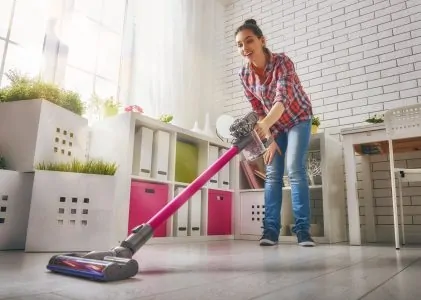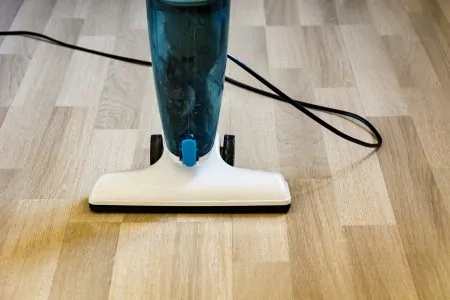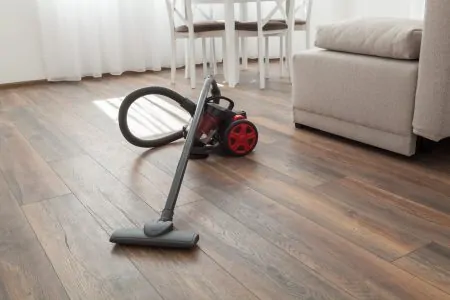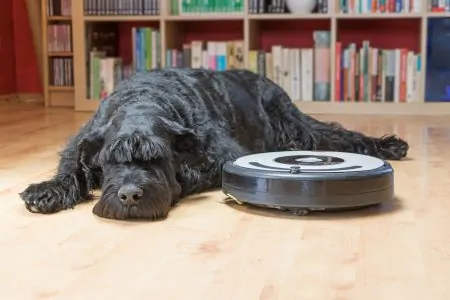Did you know that all vacuums have a life expectancy? But whether you have had it for one or 10 years, disposing of your vacuum the right way can be a challenge.
You may be tempted to drop it off in your recycling bin, hoping someone will pick it up. In reality, though, unwanted vacuums become part of the large category of electronic waste items. Also called “e-waste,” it’s considered the fastest-growing type of waste in the world (1).
It’s important that we know how to recycle our vacuum cleaners. And that’s exactly what we’re here to teach you.
Keep reading for all the reasons you should recycle your vacuum cleaner and the best five methods.
Key Takeaways
- Vacuum cleaners can be recycled and should not be thrown in regular trash.
- Recycling vacuums helps reduce e-waste, save energy, and protect the environment.
- Options for recycling vacuums include recycling centers, electronic stores, or selling parts.
- Donating a functional vacuum to a shelter or thrift store is another responsible option.
Can My Vacuum Cleaner Be Recycled?
Generally speaking, it’s important to remember that few items aren’t recyclable (2). Vacuums are made with several different materials, so cases of non-recyclable devices are extremely rare. If your device can be plugged in or comes with a battery, it can be reused. So the bottom line is: yes, you can recycle your vacuum cleaner.
Why Recycle a Vacuum Cleaner?
The importance of recycling has been brought forward in the past few years. Today, it’s critical enough to be an integral part of political discussions. What impact does recycling your vacuum have on the big picture, and what are the benefits?
1. E-Waste
E-waste is composed of any discarded electronic product, including vacuum cleaners. Because these devices tend to have a shorter lifespan than they used to, they’re becoming a real challenge.
The consumption of electronic products per household has also increased dramatically. The global vacuum cleaner market is estimated to reach US$20.5 billion in 2024.
Every year, each Canadian and American produces about 20 kilograms of e-waste. Globally, only 20 percent of electronic waste is being recycled. Even within the European Union, the leader in this field, they only report recycling 35 percent of it (3).
We — citizens and governments — should manage our e-waste more efficiently. Failing to do so could lead to the production of 120 million tons of e-waste by 2050 (4). This is more than double today’s amount.
2. Keeping Our Planet Clean
Up to 90 percent of your vacuum can be recycled. Metal components can be melted down to make new devices or parts. Plastic can also be reused to become car dashboards, plant pots, or even furniture.
Depolluting the Environment
When disposed with the regular garbage, vacuums will likely be burnt. However, vacuums aren’t biodegradable. Like many electronic devices, they contain heavy metals such as copper, iron, or aluminum.
The toxic fumes produced when such metals are burned are harmful to the environment. Over time, they accumulate in our biosphere, soil, and water. These carcinogenic compounds also accumulate in the air we breathe (5).
Reducing Carbon Dioxide Emissions
Making new vacuums produces a large amount of carbon dioxide. Using existing resources from old devices, instead, requires much less output than building everything from scratch.
Saving Energy
Recycling also helps to save an incredible amount of energy. One kilogram of recycled plastic can power a vacuum for 34 hours.
The metallic parts might be the recyclable portions of a vacuum saving the most energy. Usually, the amount of energy saved depends on the material used. Steel and iron on their own represent 72 percent of energy savings.
In one year, the United States recycled 89 million tons of general waste. This is enough energy to power 25 million American homes per year (6).
3. Economic Advantages
E-waste’s economic value represents about $62.5 billion yearly. That’s more than many countries’ Gross Domestic Product (7). So, recycling your vacuum also contributes to your country’s economic development.
While we may not think much about our economy, it does impact our daily lives. The recycling industry creates 681,000 jobs every year and generates almost $5.5 billion in tax revenue (8).
A total of 189 countries have also joined the “Basel Convention.” This convention mainly aims at exporting recycled e-waste, regulating its management. The participating countries also support third-world economies needing these parts (9).
4. Every Action Counts
These numbers might be overwhelming at first. How can recycling a small cordless stick vacuum cleaner help the planet or my country’s economy? Believe it or not, every little bit helps.
You’re potentially setting an example for a family member or friend by recycling your vacuum. You might even pass on the habit to the next generation. Individual efforts may create planet-wide miracles.
How to Recycle a Vacuum Cleaner
What are the options available to recycle your device? Keep in mind that any recycling method is better than not recycling.
1. Recycling Centers
As we mentioned, many vacuums can be reused, making them ideal candidates for recycling centers. Cords, hoses, body housing, and plastic parts can all be recuperated. You’ll find shampoo bottles or traffic cones made of plastic parts from vacuums.
If you’re not sure in which bin to place your device, onsite staff can assist you. However, some centers have limitations on what they’re able to receive. So, we recommend checking their website and contacting them before heading to your nearest center.
2. Scrap Yards
Scrap yards may even pay you to recuperate certain metallic parts. They’re often found close to heavy industry headquarters in suburban and urban areas.
Depending on the type of metal, you can expect to receive a few cents to a few dollars per pound. It may not be much, but you might get a free coffee out of it. However, they may only take metallic parts, so you’d still have to find a way to recycle the other components.
You might also have to disassemble the device and separate the pieces. But don’t worry, this sounds more difficult than it is. Even an inexperienced handyperson should be able to handle the task.
3. Electronic Stores
By offering recycling options, a few major electronic stores are doing their best to impact e-waste management positively. Some even offer a rebate or credit when giving your old device back (10).
4. Sell Parts
Some parts of your vacuum might continue their life without the device. Nozzles, brushes, hoses, and other attachments can be washed, removed, and sold.
Don’t expect much, though — for example, a stair tool might go for just a few dollars. But when you’re on a budget, anything helps. Besides, other parts like vacuum belts from older models can be challenging to find and are often in high demand.
5. Giving Your Vacuum a Second Life
Although your vacuum may not meet your needs anymore, it could be helpful to someone else. Given it’s still operational, of course.
Donation Centers and Local Shelters
Most donation centers and thrift stores accept vacuums as long they’re functional and in decent condition. Organizations such as Goodwill or Salvation Army will even pick it up from your location (11).
If your donation center doesn’t offer a pick-up service, you might want to look at “Donation Town.” Located in various cities across the United States, they’ll collect your device for free and bring it to the center of your choice (12). If helping those in need isn’t enough, some centers will even issue tax-deductible receipts.
Homeless shelters or addiction centers may also need additional cleaning devices. Use an online directory to find a homeless shelter in your area (13).
Posting It Online
Whether you’re selling or giving it away, the internet is a good place to advertise it. When posting online, pictures are essential. Take several photos from different angles, including attachments.
If you’re unsure how much you should sell your vacuum for, look for posts of similar devices. Craigslist and eBay are popular online platforms for this purpose. If you’re giving it away, you might also want to try Freecycle (14).
Swapping Events
Swapping events are a means of recycling within a community. They’re often organized to promote environmental or social issues. Schools, libraries, and community centers are likely to coordinate this type of event.
Don’t have a swapping event happening near you? It might be an excellent opportunity to organize one among your friends, family, and other acquaintances.
You might even start a new trend. Not only will you get to dispose of your vacuum, but you’ll gain something in exchange.
FAQs
Recycle Away
Vacuums aren’t biodegradable, and recycling them is essential. While we may not think our little vacuum can help in the big scheme of things, every single action counts.
It encourages other people to do the same, helps our economy, and creates jobs. Recycling your vacuum might take you a bit longer than dropping it off by a bin but it provides countless benefits.
If you can’t recycle your vacuum, you can always donate it to people in need.
